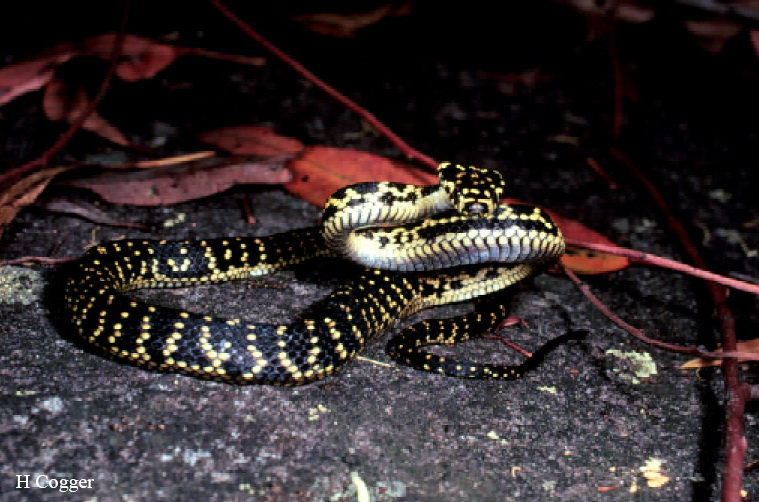Australian Broad-headed Snake (Hoplocephalus bungaroides) {!--우산코브라--> THREATENED SPECIES INFORMATION
Broad-headed Snake
Hoplocephalus bungaroides (Schlegel, 1837)
Other common names: Broad-head, Yellow-spotted Snake & Night Snake
Conservation status
The Broad-headed Snake is listed as an Endangered Species on Schedule 1 of the New South Wales Threatened Species Conservation Act, 1995 (TSC Act). This species is also listed as a Vulnerable Species on Schedule 1 of the Commonwealth Endangered Species Protection Act, 1992.
Description
The Broad-headed Snake is a medium sized, front-fanged, venomous snake (Serpentes: Elapidae). Its body colouration is generally black with lemon to golden yellow scales forming irregular cross bands, usually a single scale wide and interspaced by 3-4 black scales. Along the sides there tend to be yellow scales which interconnect the cross bands to produce a wavy or straight horizontal yellow striping. On the belly the colouration tends to be steely bluish grey but can be splotched with yellow. The broad ventral scales are keeled at their margin, an adaptation for climbing. The head is clearly distinct being much wider than the neck and is very obvious when aroused. The head is ornamented with irregularly placed yellow scales and the upper lip (labial) scales are also barred yellow. They range in size from 22-28cm total length as neonates and up to around 90cm as adults, though rarely, larger sizes have been reported. Average size is about 60cm with females tending to reach the larger sizes.
Distribution
The Broad-headed Snake is restricted to the Sydney Basin and within a radius of about 200km of Sydney. Its distribution extends from Wollemi National Park in the north; the edge of the Clyde River catchment in the ranges southwest of Nowra in the south; and west to the upper Blue Mountains at Blackheath and Newnes. Its eastern most distribution is within Royal National Park and the escarpment areas above the northern end of the Illawarra. Old records exist for parts of Sydney Harbour foreshore and the eastern suburbs pre 1920, where the species formerly occurred along rocky sections of the Sydney coastline. The historical records from the entrance of Port Jackson south to Botany Bay, and around Middle Harbour, and “the inlets of Lane Cove and Parramatta” (Krefft 1869), are very old and these populations are thought extinct. Similarly there are also older records from outlying sandstone extensions at the NW edge of the Sydney Basin between Bathurst and Mudgee. In total there are approximately 170 available specimen records of the Broad-headed Snake, but only about 50 of these could be regarded as current or recent. Their distribution today would appear to be centred in four key areas; Blue Mountains, southern Sydney, an area north west of the Cumberland Plain and the Nowra hinterland.
Recorded occurrences in conservation reserves
The species is currently known from Blue Mountains, Heathcote, Morton, Royal, Wollemi and Yengo National Parks and Parr State Recreation Area. It is thought to be present in Dharug and Popran National Parks and was historically known from areas now within Garigal, Ku-ring-gai, Lane Cove and Marramarra National Parks (NPWS 1999).
Other important areas of distribution in which the species is believed to be afforded some level of security include: Avon, Cataract, Cordeaux, Nepean and Woronora Catchment areas and the Holsworthy Military Lands on the southern outskirts of Sydney.
Habitat
The Broad-headed Snake has a preferred habitat centred on the communities occurring on the Triassic sandstone of the Sydney Basin. The sites where they occur are typified by exposed sandstone outcrops and benching and in these locations the vegetation is mainly woodland, open woodland and/or heath. The Broad-headed Snake seasonally occupies distinctive microhabitats within these broader habitat types. They utilise rock crevices and exfoliating sheets of weathered sandstone during the cooler months and tree hollows during summer (Webb & Shine 1998b). Some of the canopy tree species found to regularly co-occur at known sites include Corymbia eximia, C. gummifera, Eucalyptus sieberi, E. punctata and E. piperita (NPWS unpublished).
Ecology
The Broad-headed Snake is nocturnal to crepuscular (active at dusk) and is an ‘ambush predator’, preying predominantly on lizards, particularly Lesueurs Velvet Geckos (Wells 1981; Webb & Shine 1994), at least during the cooler months. During this time the species can be found frequenting exposed sandstone ridgetops where it refuges under exfoliating sheets of sandstone resting on naked rock or within crevices. These refuges often have a predominantly west to north westerly aspect. This aspect effect is thought to provide thermoregulatory advantage and maximises temperature levels for the peak feeding periods of early evening (Webb & Shine 1998a). During the warmer months of the year they become arboreal frequenting tree hollows (Webb 1996) and undergo a presumed dietary shift to small mammals (Shine 1983; 1990; Webb & Shine 1998b), although crepuscular arboreal skinks (Eulamprus tenuis) have also been reported in the diet of summer captured individuals (G. Turner 1998 unpublished). They give birth to live young (ovoviviparous) and tend to produce relatively low numbers of fairly advanced offspring by comparison to other snakes (Shine & Fitzgerald 1989). Clutch sizes are recorded as 4-12. Neonates are relatively large at birth but take 4-6 years to reach maturity. The snakes have an opportunistic ambush feeding strategy which results in low food intake. This has several likely consequences including low rates of growth, slow maturation and a breeding cycle that is less frequent than every year. These factors in concert may predispose the species to become threatened (Webb 1996; Webb & Shine 1998b).
National Parks and Wildlife Service (NPWS) http://www.nationalparks.nsw.gov.au/
